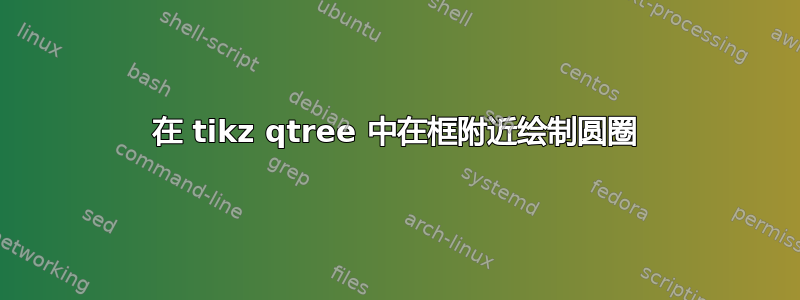
我正在尝试在节点上方绘制:
- 一个圆圈
- 一些文本

但我不知道该怎么做。这是我的临时代码
\begin{figure}
\captionof{figure}{Estructura del análisis de árbol lógico }
\centering
\begin{tikzpicture}
\tikzset{edge from parent/.style={draw,edge from parent path={(\tikzparentnode.south)-- +(0,-8pt)-| (\tikzchildnode)}}}
\tikzset{every tree node/.style={align=center,anchor=north}}
\Tree [.{Modo de falla}
[.\node[draw]{Bajo condiciones normales \\ ¿Los operarios pudieron determinar que algo ocurria?};
[.Si [.\node[draw]{¿Este modo de falla \\ causo un problema de seguridad?};]
]
[.No [.\node[draw]{Falla oculta};]
]
]]
\end{tikzpicture}
\captionsetup{font={footnotesize,it}, width=\textwidth}
\caption*{Fuente: El autor.}
\label{fig:arbol_logico}
\end{figure}
它看起来是这样的(看起来很糟糕:))

答案1
使用原始方法的树tikz-qtree:

代码:
\documentclass{article}
\usepackage[spanish]{babel}
\usepackage[T1]{fontenc}
\usepackage[utf8]{inputenc}
\usepackage{tikz-qtree}
\usepackage{caption}
\begin{document}
\begin{figure}
\captionof{figure}{Estructura del análisis de árbol lógico }
\centering
\begin{tikzpicture}
\tikzset{edge from parent/.style={draw,edge from parent path={(\tikzparentnode.south)-- +(0,-8pt)-| (\tikzchildnode)}}}
\tikzset{
every tree node/.style={
draw,
align=center,
anchor=north,
text width=5cm,
font=\sffamily
},
level 1/.style={level distance=1.5cm},
level distance=2.5cm,
sibling distance=30pt,
}
\Tree
[.\node[draw=none] {Modo de falla};
[.\node (normales) {Bajo condiciones normales, ¿los operarios pudieron determinar que algo ocurría?}; \edge node[fill=white,near end,font=\sffamily] {Sí};
[.\node (problema) {¿Este modo de falla causó un problema de seguridad?};
]
\edge node[fill=white,near end,font=\sffamily] {No};
[.\node[text width=3cm] (fallaocul) {Falla oculta};
]
]
]
\node[circle,draw,anchor=south east,font=\sffamily]
at ([yshift=6pt]fallaocul.north east) {D};
\node[anchor=south east,font=\sffamily]
at (normales.north east) {(1) Evidente};
\node[anchor=south east,font=\sffamily]
at (problema.north east) {(2) Seguridad};
\end{tikzpicture}
\captionsetup{font={footnotesize,it}, width=\textwidth}
\caption*{Fuente: El autor.}
\label{fig:arbol_logico}
\end{figure}
\end{document}
这个想法是给节点分配名称,然后使用这些名称将标签放置在所需的位置。
答案2
嗯...它是一棵树,所以我建议使用forest它来更好地处理树。
通常,我在图表中使用无衬线字体,但如果您不喜欢,可以删除我的调整;)。
以下是一个例子:
\documentclass[tikz,border=5pt,multi]{standalone}
\usepackage{forest}
\usepackage[utf8]{inputenc}
\usepackage{cfr-lm}
\usetikzlibrary{positioning}
\begin{document}
{\sffamily\plstyle
\begin{forest}
create my label/.style n args=2{
tikz={\node [font=\small, thick, anchor=south east, inner xsep=0pt, #1] at (.north east) {#2};}
},
my label/.style={
create my label={}{#1}
},
my circle label/.style={
create my label={draw, circle, yshift=5pt}{#1}
},
for tree={
align=center,
parent anchor=south,
child anchor=north,
where level=0{}{l sep+=1em},
thick,
edge={thick, rounded corners=2pt},
rounded corners=2pt,
edge path={
\noexpand\path [draw, \forestoption{edge}] (!u.parent anchor) -- +(0,-5pt) -| (.child anchor)\forestoption{edge label};
},
draw,
}
[Modo de falla
[{Bajo condiciones normales\\¿Los operarios pudieron determinar que algo ocurría?}, my label={(1) Evidente}
[ {¿Este modo de falla\\causó un problema de seguridad?}, edge label={node [pos=.75, fill=white]{Si}}, my label={(2) Seguridad}
]
[Falla oculta, edge label={node [pos=.75, fill=white]{No}}, my circle label=D
]
]
]
\end{forest}}
\end{document}
输出如下:



